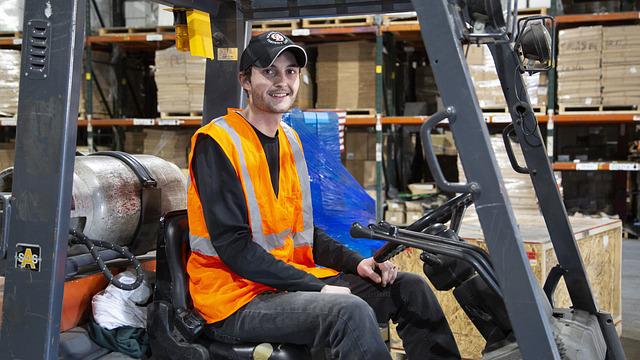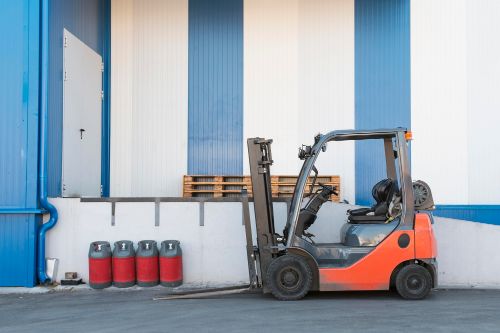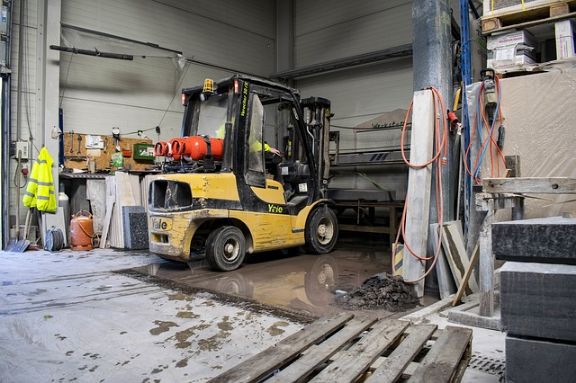
Carbon monoxide is a colorless, odorless gas that can be dangerous to human health if it is present in high concentrations or if exposure is prolonged. As a result, many industrial workplaces have strict regulations regarding carbon monoxide.
Forklifts run on liquid propane and are common in industrial warehouses and storage depots as they are more economical to operate than diesel-powered machines due to their lower fuel consumption. Hence, owners of propane forklifts and other heavy equipment must ensure their machines do not produce excessive carbon monoxide emissions as a result of their operation.
However, you may be wondering if a propane forklift produces carbon monoxide and whether your workplace safety officer will approve its use.
Read on to learn more about the presence of this gas and how you can reduce the chances of operating one that produces excessive levels of carbon monoxide…
Does a Propane Forklift Produce CO Gas?
All propane-powered equipment such as a forklift produces carbon monoxide. This gas is a by-product when propane is burned in the internal combustion engine. It has been observed that older forklifts – no matter what models, tend to produce more carbon monoxide compared to newer ones. An average of 5,000 PPM of CO is produced by newer models while older models are significantly higher at an average of 30,000 PPM.
Regular inspection, keeping the vehicle in tip-top shape, and inspection of the fuel system for any damage that could cause a leak, can considerably reduce exposure to CO gas. Installation of a catalytic converter can reduce the release of this gas.
When working with a propane forklift, sufficient ventilation is important. Never use a diesel or gasoline-powered forklift indoors.
Propane Forklifts vs. Other Forklift Types
| Forklift Type | CO Emissions | Other Emissions | Efficiency |
|---|---|---|---|
| Propane Forklifts | While propane burns cleaner than gasoline and diesel, incomplete combustion can lead to CO emissions. | Reduced emissions of nitrogen oxides (NOx) and particulate matter compared to diesel forklifts. | Generally offer a consistent power supply and can operate continuously as long as they’re refueled. |
| Electric Forklifts | Direct operation results in zero emissions, including CO. However, the emissions profile of electricity production (at the source) can vary based on how the power is generated. | Virtually no direct emissions of pollutants. The total emissions profile depends on the energy source (e.g., coal, solar, wind). | Typically quieter and can operate indoors without concerns of exhaust emissions. |
| Diesel Forklifts | Generally, produce less CO than propane forklifts but can emit a significant amount if not properly maintained or if combustion is incomplete. | Higher NOx, sulfur oxides (SOx), and particulate matter emissions compared to propane forklifts. | Often chosen for heavy lifting and outdoor operations due to their power and robustness. |
Read related article: What Kind of Propane Does a Forklift Use? (is it Hd-5, Hd-10?)
Factors Influencing Carbon Monoxide Production
Carbon monoxide poisonous gas that is a byproduct of incomplete combustion. When considering propane-powered forklifts, the production and accumulation of CO is a genuine concern for worker safety. Various factors can influence production in such settings. In this discussion, we will delve into three main factors: engine tuning and maintenance, quality of propane, and ventilation.
1. Engine Tuning and Maintenance: Influencing the Efficiency of Combustion
- Basics of Combustion: For efficient combustion, an engine requires an optimal mixture of air and fuel. When combustion is complete, propane (C3H8) is transformed into carbon dioxide (CO2) and water (H2O). However, when combustion is incomplete, carbon monoxide can form.
- Tuning Implications: A poorly tuned engine or one with faulty components might not mix air and fuel properly. This sub-optimal mixture increases the likelihood of incomplete combustion and, consequently, CO production.
- Maintenance: Over time, components like spark plugs, air filters, and fuel injectors can degrade or become dirty. Regular maintenance ensures these components function optimally, ensuring better combustion and reducing the risk of CO production.
2. Quality of Propane: Contaminants and Their Role in CO Production
- Propane Purity: Ideally, propane used for forklifts should be of high purity. Impurities or contaminants in the fuel can hinder efficient combustion.
- Common Contaminants: Some potential contaminants in propane include butane, water vapor, and oil residues. While small amounts might not be harmful, high levels can influence combustion characteristics.
- CO Production: Contaminants can cause the fuel mixture to burn less efficiently, leading to incomplete combustion and generation of this gas.
3. Ventilation: The Role of Workspace Ventilation in Diluting or Accumulating CO
- The Necessity of Ventilation: In confined spaces, any carbon monoxide produced can quickly accumulate, posing serious health risks. Proper ventilation can disperse this gas, reducing its concentration and mitigating its effects.
- Ventilation Rates: The rate at which fresh air replaces old air in a space can greatly influence the gas concentration. Poorly ventilated areas can have CO build up quickly even if the production rate is relatively low.
- Detection and Monitoring: In areas where propane forklifts are operated, especially indoors, it’s essential to have CO detectors. These devices can alert workers when levels approach dangerous thresholds, prompting them to either improve ventilation or evacuate.
Situations Where Propane Forklifts Might Produce More or Less CO Relative to Alternatives:
- More CO than Electric Forklifts:
- Indoor Operations: Electric forklifts are preferred for indoor operations because they produce zero direct emissions. In contrast, propane forklifts, if not well-maintained or if operated in poorly ventilated areas, can produce and accumulate CO.
- Less CO than Diesel Forklifts:
- Well-Maintained Engines: A well-maintained propane forklift engine generally produces less CO than a similar diesel engine, especially if the diesel engine is older or not well-maintained.
- Optimal Combustion Conditions: When propane combusts under optimal conditions (right air-fuel mixture and efficient spark), it can produce minimal gas, often less than diesel counterparts.
- Variable CO Production:
- Outdoor vs. Indoor: While outdoor operations provide natural ventilation that reduces CO concentration, propane forklifts operating indoors, especially in confined spaces, can lead to CO buildup if not properly ventilated.
- Maintenance: Propane forklifts with outdated components, poor tuning, or clogged air filters can produce more CO than their well-maintained counterparts or even compared to well-maintained diesel forklifts.
The production and accumulation of CO in workplaces using propane forklifts is influenced by several factors. Regular maintenance of engines, ensuring the purity of propane, and maintaining proper ventilation are all crucial to ensuring the safety of workers. Employers and forklift operators should be keenly aware of these factors and actively work to mitigate the associated risks.
Read related article: What are the Forklift Propane Tank Inspection Requirements?
Forklift Safety Practices for Working with Propane
When operating a propane-powered lift truck, there are a few precautions you should take to protect employees from CO exposure. These include:
Using a CO detector at work, like an indoor monitor or a personal monitor. Indoor CO monitors can provide visual, audible and/or visual warnings when the level in the building is unsafe. They are usually placed near the entrance to the building to detect CO as people enter the building and can be useful in detecting leaks in the building.
Checking the safety of your forklift’s fuel system, including the fuel line and fuel tank, when you start work. This is best done with a visual inspection.
Stopping work if you suspect a leak. Emergency procedures should include stopping work when a leak is suspected, as immediate action is required to prevent exposure.
Checking the amount of CO being released at the end of the shift. If a leak is suspected, a full leak detection and repair procedure should be followed.
Allocating sufficient time for the safe shutdown of machinery, including the safe shutdown of forklift engines.
Ensuring that all employees are trained in the safe operation of forklifts, including the ways in which they produce CO.
Producing CO Doesn’t Mean the Forklift is Broken
In some instances, a forklift that is properly maintained may produce CO even when it’s not being used. This can happen if the forklift is left in a confined space without adequate ventilation. This can also happen if there is a leak in the fuel system that allows this gas to build up.
In these instances, the CO is not coming from the burning of the propane; it is being produced by the propane itself. This is why visual and audible warnings, such as those provided by detectors, can be helpful.
They can prompt you to investigate the source of the CO and take corrective action to remove the CO from the confined space or repair the fuel system leak.
Read related article: Do Forklifts Run on Liquid or Gas Propane? (The Reason Why)
Safety Practices to Protect Employees From CO
There are a few ways to protect employees from CO in the engine compartment, including:
Using proper fuel – Always use fresh, clean and high-quality fuel. Using rotten or contaminated fuel can result in excess amounts of acids being produced in the engine compartment.
Checking the engine compartment – Perform visual inspections of the engine compartment on a regular basis. Look for signs of leaks, including pooling liquids, discoloration and abnormal noises, as well as any changes in the engine compartment.
Ensuring proper ventilation – Provide proper ventilation within the engine compartment. This may include exhaust fans, open doors, windows or other openings that allow fresh air to flow into the engine compartment.
How to reduce the chances of a propane forklift producing excessive CO?
There are a number of steps that must be taken to reduce the risk of a propane forklift producing high levels of carbon monoxide. These include:
Best Practices for Maintaining Propane Forklifts to Reduce CO Emissions
- Regular Maintenance Checks: Schedule routine maintenance checks to ensure all engine components are working correctly. This involves checking spark plugs, air filters, fuel injectors, and other critical parts.
- Fuel System Inspection: Ensure there are no leaks in the fuel system. A leak can not only waste fuel but can also pose a significant safety risk.
- Adequate Air Intake: Ensure the forklift’s air intake system is clean and unobstructed. A good supply of air is essential for complete combustion.
- Exhaust System Monitoring: Regularly inspect the exhaust system for any blockages or leaks. An efficient exhaust system helps in reducing emissions.
Advancements in Forklift Engines that Minimize CO Production
- Fuel Injection Systems: Modern fuel injection systems provide a more precise mixture of air and fuel, ensuring more complete combustion and fewer emissions.
- Oxygen Sensors: These sensors monitor the oxygen content in the exhaust. If there’s too much oxygen, it indicates incomplete combustion, and the engine can adjust accordingly.
- Catalytic Converters: These can be added to the exhaust system of propane forklifts. They facilitate the conversion of CO into less harmful CO2 before it’s emitted into the atmosphere.
- Engine Control Modules (ECM): Advanced ECMs can optimize engine performance by adjusting parameters in real-time based on current operating conditions, thereby reducing production.
Detecting Excessive CO in a Propane Forklift
Many workplaces have equipment that is designed to measure the level of carbon monoxide in the air.
This equipment, known as a CO monitor, can be used to monitor the level of this gas in the forklift operator’s breathing space. Additionally, the CO monitor will indicate the level of this gas in the general vicinity of the forklift.
If the level of carbon monoxide is above the permissible level, the operator may be reluctant to operate the forklift, especially if the CO is concentrated around the operator’s seat. Employers should, therefore, install a CO monitor in areas where propane forklifts are operated, as well as any other areas where the level is close to or exceeds permissible limits.
These areas may include areas where propane cylinders are stored or filled, as well as areas where forklifts are refueled. CO monitors are relatively inexpensive, but they can help prevent carbon monoxide incidents, particularly in industrial settings where forklifts are operated regularly.
Recommendations for Workplace Safety Measures
- Strategic Placement of Monitors: Install CO monitors in areas where propane forklifts operate frequently, especially if they’re enclosed or partially enclosed spaces.
- Regular Calibration: Ensure that monitors are calibrated regularly to maintain accuracy.
- Visual and Audible Alarms: Monitors should have both visual and audible alarms that trigger when levels approach unsafe thresholds.
- Ventilation Systems: In addition to monitoring, workplaces should have efficient ventilation systems to disperse this gas and prevent its accumulation. These systems should be inspected and cleaned regularly.
- Training and Awareness: Workers and forklift operators should be trained about the dangers of this gas. They should be made aware of the symptoms of CO poisoning, such as dizziness, headaches, and shortness of breath, and what actions to take if they suspect exposure.
Reporting of Poisoning
Although it is an invisible gas, carbon monoxide poisoning is a medical emergency. Therefore, businesses must have procedures in place to report and record incidents of carbon monoxide poisoning.
For example, workers who suffer poisoning as a result of the presence of CO at work must be treated by a medical professional, with a record of the incident being kept.
This record must be kept, as many states have laws requiring such documentation to be maintained for a minimum period of time. Businesses must report all incidents of poisoning to state and federal safety officials.
This will help them determine if there is a widespread problem with emissions in the workplace. In order to ensure accurate reporting, businesses must ensure their workers are aware of the nature of CO poisoning and how to identify it.
Any workers who suspect they have been affected by carbon monoxide poisoning at work must report the incident.
Recognizing the Symptoms
If you suspect a colleague is suffering from poisoning, you should take them to see a doctor immediately.
• Headaches or feeling groggy or dizzy
• Nausea or vomiting – Shortness of breath
• Shallow, irregular breathing
• Chest pain
• Drowsiness or confusion
• Unconsciousness
If a colleague is suffering from poisoning, they must be taken to a doctor as soon as possible. Carbon monoxide poisoning can be fatal if left untreated, so it is important to be vigilant in searching for the signs of exposure.
FAQs
What are the hazards of propane forklifts?
Propane forklifts, while offering numerous advantages, do come with specific hazards:
- Fire and Explosion: Propane is flammable. Any leak can create a fire or explosion risk, especially if there’s an ignition source nearby.
- Carbon Monoxide Emission: Incomplete combustion in propane-powered engines can produce carbon monoxide (CO), a toxic gas.
- Gas Leak: A punctured or damaged propane tank can leak, leading to the accumulation of propane gas, which is a suffocation hazard.
- Cylinder Handling: Mishandling propane cylinders during changing or refilling can result in injuries.
Is it safe to use a propane forklift indoors?
It can be safe to use propane forklifts indoors, provided that:
- The area is well-ventilated to prevent the buildup of harmful gases like CO.
- The forklift is regularly maintained to ensure optimal combustion and minimize CO emissions.
- Carbon monoxide monitors are in place to alert of increased CO levels.
Is carbon monoxide an issue with propane?
Yes, incomplete combustion of propane can produce carbon monoxide. Proper maintenance and ensuring adequate oxygen for combustion can minimize CO production.
Can a propane tank leak cause carbon monoxide?
Directly, no. A propane tank leak releases propane gas, not carbon monoxide. However, if leaked propane is subsequently ignited and burns in an area with poor oxygen supply, it can result in incomplete combustion, which produces carbon monoxide.
Does propane produce more carbon monoxide than natural gas?
Both propane and natural gas can produce carbon monoxide when they undergo incomplete combustion. Generally, properly tuned and maintained appliances and engines ensure complete combustion, minimizing CO emissions. However, when comparing the two, propane is more likely to produce higher amounts of CO under suboptimal conditions than natural gas.
How does propane create carbon monoxide?
Propane creates carbon monoxide when it burns without enough oxygen. Incomplete combustion means that not all the propane molecules react with oxygen, resulting in the formation of carbon monoxide instead of carbon dioxide.
Does propane heat cause carbon monoxide?
Any heating system or appliance that burns fuel, including those using propane, can produce carbon monoxide if there’s incomplete combustion. For propane heaters, regular maintenance, proper ventilation, and ensuring a good supply of combustion air are crucial to reduce the risk of CO production.
Summing Up
Upon analyzing the various types of forklifts in terms of their emissions and efficiency, some key findings emerge:
- Propane Forklifts: While propane forklifts burn cleaner than diesel, they can still produce emissions due to incomplete combustion. However, when compared to diesel counterparts, they often emit fewer pollutants such as nitrogen oxides (NOx) and particulate matter.
- Electric Forklifts: These stand out for their zero direct emissions, especially CO, making them a top choice for indoor operations. Nonetheless, their overall environmental footprint is contingent upon the source of their electricity.
- Diesel Forklifts: Though powerful and robust, diesel forklifts typically have a higher emissions profile compared to propane forklifts. Their emissions can be particularly concerning if the engines are not well-maintained.
The analysis underscores the importance of safety and awareness in forklift operations, especially for those powered by propane. While propane forklifts offer numerous advantages, such as consistent power and fewer emissions compared to diesel, the potential for CO emissions necessitates strict adherence to safety protocols. Proper maintenance, regular checks, adequate ventilation, and the use of CO monitors are all crucial components of ensuring a safe operating environment.
In essence, while each forklift type has its place in different operational contexts, it’s paramount that operators and supervisors prioritize safety and awareness, especially when propane forklifts are in use.

Mike is an experienced propane technician with over 15 years of professional experience in the field. He has dedicated his career to helping customers with their propane needs, from installation to maintenance and repair. Together with Jeremy, he co-founded this website to provide useful information and guidance to customers seeking reliable propane services.




